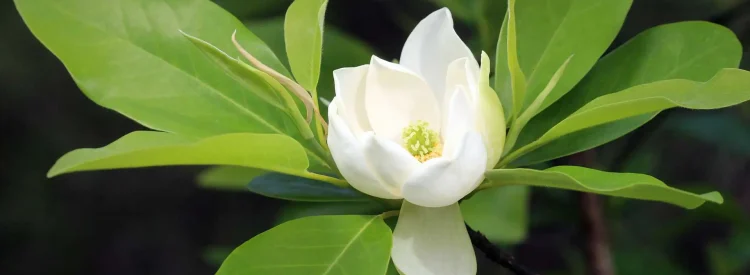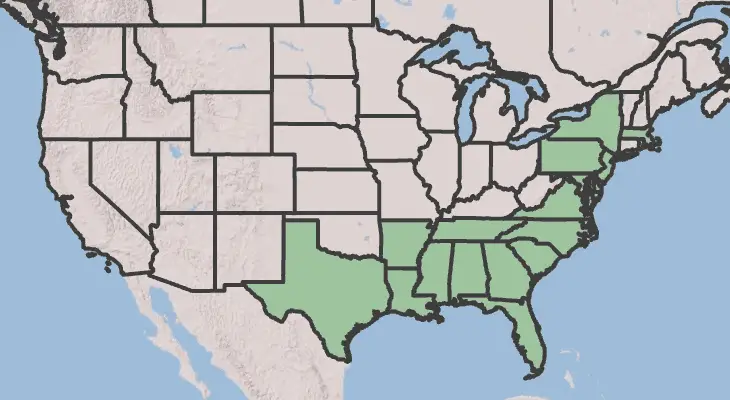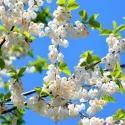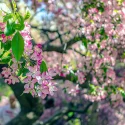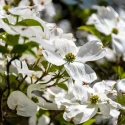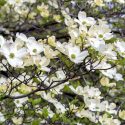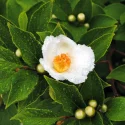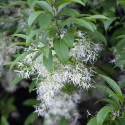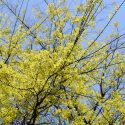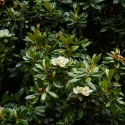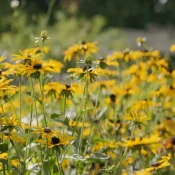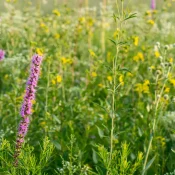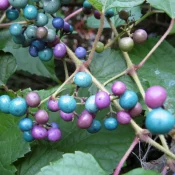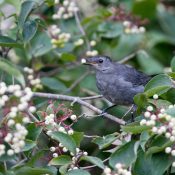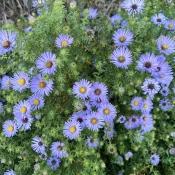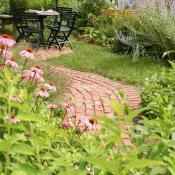Sweetbay Magnolias are gorgeous, glossy-leafed, mostly evergreen, native trees. Sweetbays are one of eight magnolias native to North America. Their sweet-smelling ivory flowers appear in the spring, followed by red berries in the summer. They thrive in a wide range of light, from part sun to sun. Sweetbay Magnolias can be grown almost anywhere on the East Coast, from the Northeast, Mid-Atlantic, and down to the South. Scroll on for planting tips.
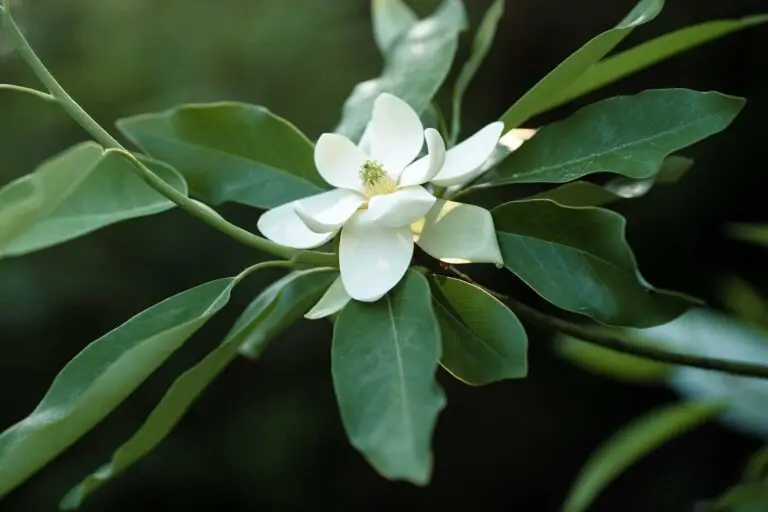
In the realm of native plants, few can rival the iconic elegance of the Sweetbay Magnolia (Magnolia virginiana). Native to a large swath of the United States, this magnificent tree looks amazing in yards and helps pollinators and songbirds. Sweetbay Magnolias are one of the eight magnolias native to North America (here’s a list of the other native magnolias.) In this article, we’ll explore the wonders of the Sweetbay Magnolia, including how to grow and where to find one. Let’s dig in with a basic question:
What are the benefits of planting a Sweetbay Magnolia?
There are many benefits to planting native Sweetbay Magnolias:
Sweetbay Magnolias help wildlife
Sweetbay Magnolias provide habitat for a range of wildlife, from birds to insects. Their piles of blooms also support pollinators like bees and butterflies, which depend on flowers for pollen and nectar.
Sweetbay Magnolias are beautiful
Sweetbay Magnolias are known for their stunning blooms, which also smell amazing. They are also evergreen, which means no matter the season or weather, they will always have leaves.
Planting native Sweetbay Magnolias saves time and money
Native Sweetbays are low-maintenance plants that require little watering or fertilization once established. They are also relatively pest and disease resistant. Compare this low-key level of care to how much time and money it takes for lawns and get some time (and money) back!
New to native?
Before lawns and landscaping, native plants were here. They’ve fed birds, bees, and butterflies for thousands of years—and they’ll do the same in your yard. The best part? They’re easier to grow than you think.
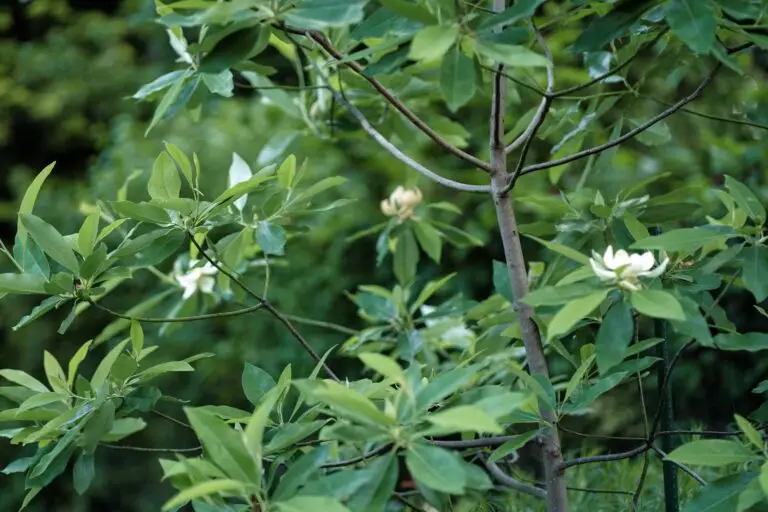
Sweetbays were the first magnolia shipped to Europe
This tree has had its fans for literally centuries. Sweetbay Magnolia was the first magnolia brought back to Europe for cultivation in the 17th century.
In the 19th century, it was still a plant favorite. When Sweetbays were found in Massachusetts in the early 1800s, it started a plant obsession that left very few Sweetbays in the wild in Northern states. There are very few trends to pick up from the 17th century (we’ll keep our antibiotics and leech-free life, thank you), but planting Sweetbay Magnolias is one of them.
What is Sweetbay Magnolia’s native range?
Sweetbay Magnolias are native to most of the Eastern seaboard, from Massachusetts down to Florida and west to Texas. They can look and behave a little differently, depending on which region they’re in. Read on to see how they change depending on if they’re in the north or south.
FAQs
How tall do Sweetbay Magnolias get?
The height of Sweetbay Magnolias depends on the region in which the tree is planted.
- In the Northeast and Mid-Atlantic regions, it can grow up to 20 feet.
- In the South, it can soar to as high as 90 feet.
Are Sweetbay Magnolias evergreen?
In most climates, Sweetbays are evergreen.
Regardless of the region, Sweetbay Magnolias will keep their leaves year-round unless there is a severely cold winter. During cold Northeast winters, the tree can drop its leaves to protect its energy. The leaves will come back in the spring.
Why are Sweetbay Magnolias sometimes called Beaver Trees?
On the east coast, Mountain Laurels bloom from the spring to the late spring. When Mountain Laurels are in bloom, they are knockouts. The Brooklyn Botanic Garden says it beautifully:
According to a 1925 guide to North American Wildflowers, beavers were “so fond of the bark that it was employed frequently to bait beaver traps.” This history is also why it also goes by the common name “beaver tree.”
How to grow Sweetbay Magnolias
Sweetbay Magnolias like wetter areas. In nature, they are often found in or near swamps and bogs. If you’re planting in a non-wet area, be sure to give them water during dry periods, particularly during the first year when they are getting established.
Sweetbay Magnolias like full sun to part sun. The only thing they don’t like is full shade. The more sun they get, the more leaves and flowers they will be able to produce.
Provenance helps when getting a Sweetbay
Speaking of winter resiliency… where you get a Sweetbay Magnolia from will help its survival in the cold. Where a plant’s DNA comes from is called its provenance.
Sweetbay Magnolias are from a wide swath of the eastern US, and within that range, there are Sweetbays that are regionally inclined. Sweetbays from the Northeast are tougher in cold winters than a Sweetbay from a more Southern state. This is another reason why it’s so important to buy from your local nurseries, particularly those nurseries that specialize in native plants.
With this in mind, we have a tip:
Plants and seeds grown close to home are tuned to your soil, weather, and pollinators. Stay within 500 miles—or about a day’s drive—to help your garden thrive naturally.
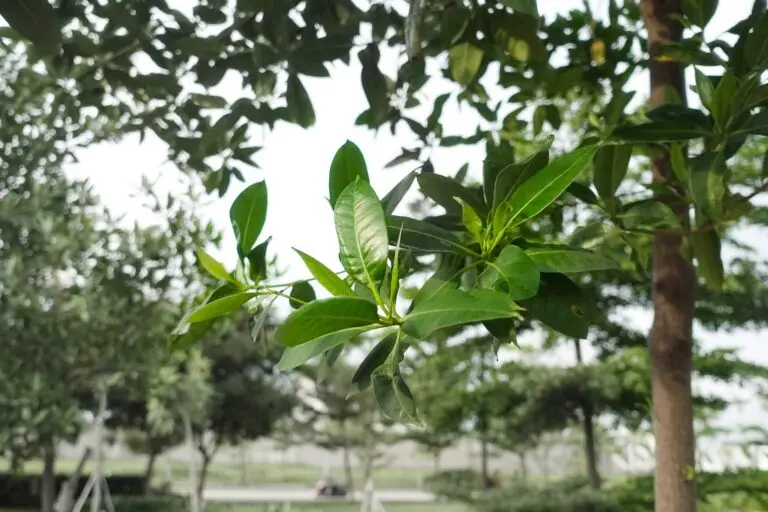
What to plant with Sweetbay Magnolias
Sweetbay Magnolias are perfectly paired with other native plants that like sun or part sun. Some favorites include:
In conclusion, Sweetbay Magnolias have been garden favorites for centuries and they deserve a place in our gardens today. No matter the season, Sweetbays are beautiful while providing food and shelter for pollinators and songbirds. Use the history, care, and tips here to plant one of these gorgeous trees and watch them return decades of beauty. Don’t forget to visit our Beginner’s Guide to Native Magnolias to meet other gorgeous native options. Happy planting!
Sources
- Harris, Marjorie. Botanica North America: The Illustrated Guide to Our Native Plants, Their Botany, History, and the Way They Have Shaped Our World. (2003), 141-142.
- Nelson, Gil. Best Native Plants for Southern Gardens: A Handbook for Gardeners, Homeowners, and Professionals, (2010).
- Walcott, Mary Vaux, and Lessing J. Rosenwald Collection. North American wild flowers. Washington, D.C., The Smithsonian Institution, 1925. PDF.
What if your feed was actually good for your mental health?
Give your algorithm a breath of fresh air and follow us.
